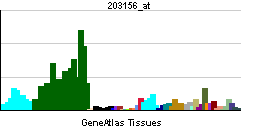AKAP11: Difference between revisions
Jump to navigation
Jump to search
m (Robot: Automated text replacement (-{{WikiDoc Cardiology Network Infobox}} +, -<references /> +{{reflist|2}}, -{{reflist}} +{{reflist|2}})) |
(No difference)
|
Revision as of 13:55, 4 September 2012
| A kinase (PRKA) anchor protein 11 | |||||||||
|---|---|---|---|---|---|---|---|---|---|
| Identifiers | |||||||||
| Symbols | AKAP11 ; AKAP220; DKFZp781I12161; FLJ11304; KIAA0629; PRKA11 | ||||||||
| External IDs | Template:OMIM5 Template:MGI HomoloGene: 8279 | ||||||||
| |||||||||
| RNA expression pattern | |||||||||
 | |||||||||
 | |||||||||
| More reference expression data | |||||||||
| Orthologs | |||||||||
| Template:GNF Ortholog box | |||||||||
| Species | Human | Mouse | |||||||
| Entrez | n/a | n/a | |||||||
| Ensembl | n/a | n/a | |||||||
| UniProt | n/a | n/a | |||||||
| RefSeq (mRNA) | n/a | n/a | |||||||
| RefSeq (protein) | n/a | n/a | |||||||
| Location (UCSC) | n/a | n/a | |||||||
| PubMed search | n/a | n/a | |||||||
A kinase (PRKA) anchor protein 11, also known as AKAP11, is a human gene.[1]
The A-kinase anchor proteins (AKAPs) are a group of structurally diverse proteins, which have the common function of binding to the regulatory subunit of protein kinase A (PKA) and confining the holoenzyme to discrete locations within the cell. This gene encodes a member of the AKAP family. The encoded protein is expressed at high levels throughout spermatogenesis and in mature sperm. It binds the RI and RII subunits of PKA in testis. It may serve a function in cell cycle control of both somatic cells and germ cells in addition to its putative role in spermatogenesis and sperm function.[1]
References
Further reading
- Lester LB, Scott JD (1997). "Anchoring and scaffold proteins for kinases and phosphatases". Recent Prog. Horm. Res. 52: 409–29, discussion 429-30. PMID 9238861.
- Michel JJ, Scott JD (2002). "AKAP mediated signal transduction". Annu. Rev. Pharmacol. Toxicol. 42: 235–57. doi:10.1146/annurev.pharmtox.42.083101.135801. PMID 11807172.
- Nakajima D, Okazaki N, Yamakawa H; et al. (2003). "Construction of expression-ready cDNA clones for KIAA genes: manual curation of 330 KIAA cDNA clones". DNA Res. 9 (3): 99–106. PMID 12168954.
- Lester LB, Coghlan VM, Nauert B, Scott JD (1996). "Cloning and characterization of a novel A-kinase anchoring protein. AKAP 220, association with testicular peroxisomes". J. Biol. Chem. 271 (16): 9460–5. PMID 8621616.
- Ishikawa K, Nagase T, Suyama M; et al. (1998). "Prediction of the coding sequences of unidentified human genes. X. The complete sequences of 100 new cDNA clones from brain which can code for large proteins in vitro". DNA Res. 5 (3): 169–76. PMID 9734811.
- Schillace RV, Scott JD (1999). "Association of the type 1 protein phosphatase PP1 with the A-kinase anchoring protein AKAP220". Curr. Biol. 9 (6): 321–4. PMID 10209101.
- Reinton N, Collas P, Haugen TB; et al. (2000). "Localization of a novel human A-kinase-anchoring protein, hAKAP220, during spermatogenesis". Dev. Biol. 223 (1): 194–204. doi:10.1006/dbio.2000.9725. PMID 10864471.
- Schillace RV, Voltz JW, Sim AT; et al. (2001). "Multiple interactions within the AKAP220 signaling complex contribute to protein phosphatase 1 regulation". J. Biol. Chem. 276 (15): 12128–34. doi:10.1074/jbc.M010398200. PMID 11152471.
- Schillace RV, Andrews SF, Liberty GA; et al. (2002). "Identification and characterization of myeloid translocation gene 16b as a novel a kinase anchoring protein in T lymphocytes". J. Immunol. 168 (4): 1590–9. PMID 11823486.
- Tanji C, Yamamoto H, Yorioka N; et al. (2002). "A-kinase anchoring protein AKAP220 binds to glycogen synthase kinase-3beta (GSK-3beta ) and mediates protein kinase A-dependent inhibition of GSK-3beta". J. Biol. Chem. 277 (40): 36955–61. doi:10.1074/jbc.M206210200. PMID 12147701.
- Ota T, Suzuki Y, Nishikawa T; et al. (2004). "Complete sequencing and characterization of 21,243 full-length human cDNAs". Nat. Genet. 36 (1): 40–5. doi:10.1038/ng1285. PMID 14702039.
- Dunham A, Matthews LH, Burton J; et al. (2004). "The DNA sequence and analysis of human chromosome 13". Nature. 428 (6982): 522–8. doi:10.1038/nature02379. PMID 15057823.
- Ewing RM, Chu P, Elisma F; et al. (2007). "Large-scale mapping of human protein-protein interactions by mass spectrometry". Mol. Syst. Biol. 3: 89. doi:10.1038/msb4100134. PMID 17353931.
| This protein-related article is a stub. You can help Wikipedia by expanding it. |